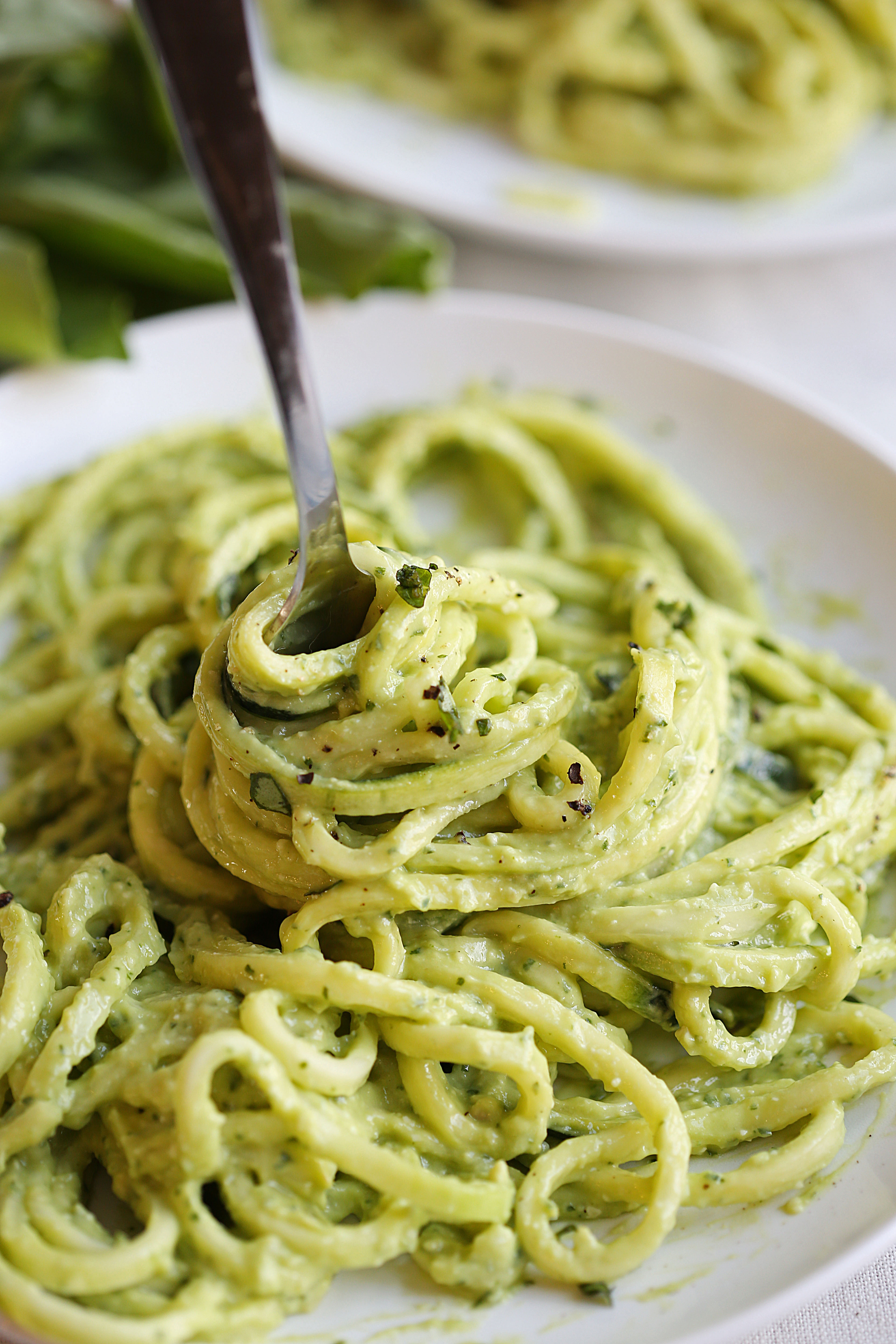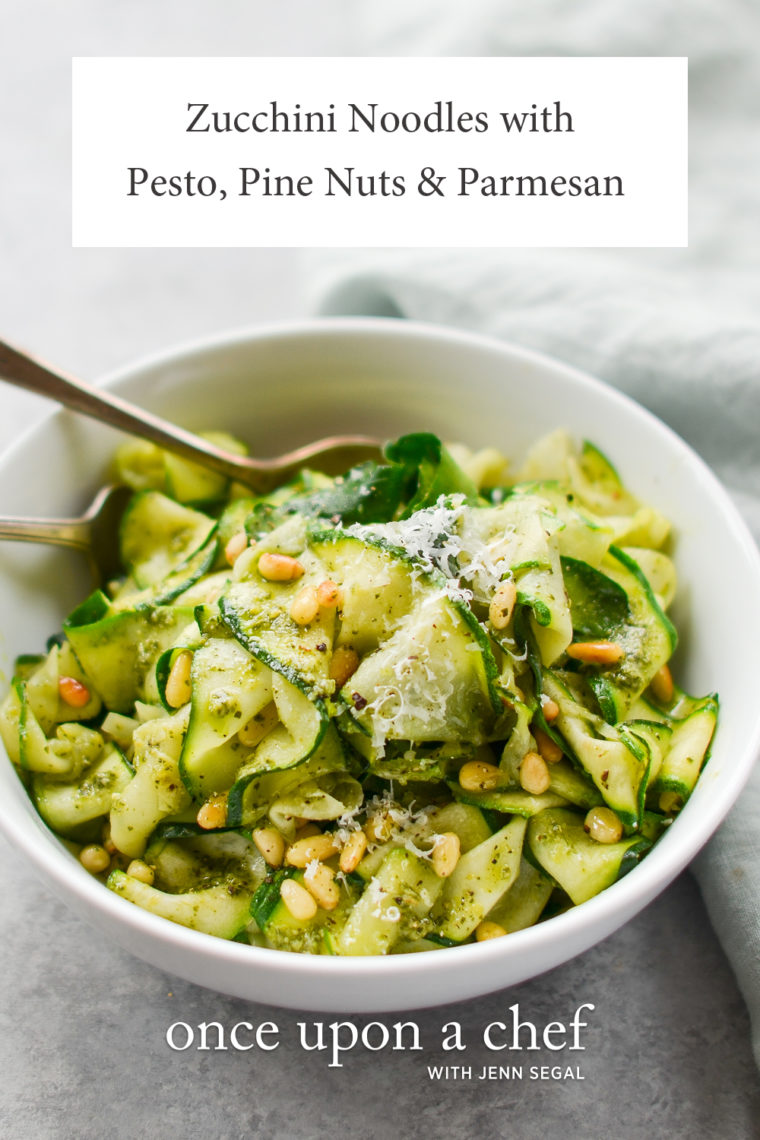Contents
I. Introduction to Zucchini Noodles With Pesto
:max_bytes(150000):strip_icc()/5528725-0a8046e2f56446e9b9b946161d74454c.jpg)
Welcome to the world of zucchini noodles with pesto, a delicious and healthy alternative to traditional pasta dishes. If you’re looking for a lighter option that still satisfies your cravings, zucchini noodles, also known as zoodles, are the perfect choice.
Zoodles are made from fresh zucchini that has been spiralized into noodle-like shapes. They offer a gluten-free and low-carb option for those who want to reduce their carbohydrate intake or follow a specific dietary plan. Not only are they nutritious, but they also provide a delightful texture and absorb flavors wonderfully.
When paired with pesto sauce, zucchini noodles become even more delectable. Pesto is an Italian sauce typically made from fresh basil leaves, garlic, pine nuts, Parmesan cheese, and olive oil. It offers a rich taste that enhances the natural flavors of the zoodles without overpowering them.
1. The Health Benefits
Zucchini noodles are packed with nutrients such as vitamins A and C, potassium, and dietary fiber while being extremely low in calories and fat content. Incorporating these nutritious vegetables into your diet can help boost your immune system, promote healthy digestion, regulate blood pressure levels, and support weight management efforts.
2. Easy Preparation
Making zucchini noodles is incredibly simple! All you need is a spiralizer or vegetable peeler to create long strands resembling spaghetti or fettuccine. Once you’ve prepared your zoodles, blanch them quickly in boiling water for 1-2 minutes or sauté them lightly in olive oil until tender yet firm.
3. Versatility in Serving
The beauty of zucchini noodles lies in their versatility – they can be enjoyed both raw and cooked. Raw zoodles retain a crisp texture, perfect for salads or cold dishes, while cooked zoodles become softer and resemble traditional pasta. Whether you prefer them served hot or cold, zucchini noodles adapt well to various cooking methods and pair excellently with different sauces.
4. Flavorful Pesto Sauce
Pesto sauce adds a burst of flavor to zucchini noodles. Its vibrant green color and aromatic ingredients create a delightful sensory experience that complements the mild taste of the zoodles perfectly. The combination of fresh basil, garlic, Parmesan cheese, pine nuts, and olive oil results in a creamy yet tangy sauce that coats each strand of zucchini deliciously.
Now that you’re familiar with the basics of zucchini noodles with pesto, get ready to embark on a culinary adventure full of healthy indulgence. This versatile dish opens up endless possibilities for creativity in your kitchen while providing a wholesome alternative to traditional pasta meals.
II. Benefits of Zucchini Noodles

Zucchini noodles, also known as zoodles, have gained popularity in recent years due to their numerous health benefits. These vegetable-based noodles are not only delicious and versatile but also offer a range of advantages for those looking to incorporate more nutritious options into their diet.
1. Low in Calories and Carbohydrates
One of the major benefits of zucchini noodles is their low calorie and carbohydrate content compared to traditional pasta. By substituting regular pasta with zoodles, you can significantly reduce your overall calorie intake and maintain a healthier weight. Additionally, zucchini noodles are an excellent option for individuals following low-carb or ketogenic diets.
2. Rich in Nutrients
Zucchini is packed with essential vitamins and minerals that contribute to overall well-being. These include vitamin C, which boosts the immune system; vitamin A, important for eye health; potassium, which helps regulate blood pressure; and manganese, necessary for bone health.
3. High in Fiber
Fiber plays a crucial role in maintaining good digestive health and promoting regular bowel movements. Zucchini noodles are an excellent source of dietary fiber that can aid digestion while preventing constipation.
4. Supports Weight Loss Efforts
If you’re trying to shed some pounds or maintain a healthy weight, incorporating zucchini noodles into your meals can be beneficial. The high water content combined with the fiber present in zoodles helps keep you feeling full for longer periods while reducing cravings.
5. Versatile Substitute
Zucchini noodles provide a versatile alternative to traditional pasta dishes without sacrificing flavor or texture significantly.
They can be used as a base for various sauces such as marinara or pesto or even added to soups and stir-fries. The mild taste of zucchini allows it to pair well with a wide range of flavors, making it an adaptable option in the kitchen.
III. How to Make Zucchini Noodles With Pesto

Making zucchini noodles with pesto is a simple and delicious way to enjoy a healthy, low-carb alternative to traditional pasta. Whether you’re following a specific diet or just looking for a lighter meal option, this recipe will satisfy your cravings while keeping things nutritious.
Gather Your Ingredients
To make zucchini noodles with pesto, you’ll need the following ingredients:
- 2 medium-sized zucchinis
- 1 cup of fresh basil leaves
- 1/4 cup of pine nuts
- 2 cloves of garlic
- 1/4 cup of grated Parmesan cheese (optional)
- Juice of half a lemon
Create the Zucchini Noodles
The first step is to transform your zucchinis into noodles. You can do this easily using a spiralizer, julienne peeler, or even just by thinly slicing them lengthwise with a knife. Once you’ve prepared the zucchini noodles, set them aside.
Prepare the Pesto Sauce
In a food processor or blender, combine the basil leaves, pine nuts, garlic cloves, Parmesan cheese (if using), and lemon juice. Blend until all the ingredients are well combined and form a smooth paste-like consistency.
Cooking Instructions:
-
Pan-frying Method:
– Heat some olive oil in a large skillet over medium heat.
– Add the zucchini noodles to the skillet and sauté them for about 2-3 minutes, or until they are tender.
– Pour the pesto sauce over the zucchini noodles and toss everything together until well-coated.
– Cook for an additional minute to warm up the pesto sauce.
– Remove from heat and serve immediately. Enjoy your zucchini noodles with pesto!
Raw Method:
– Place the zucchini noodles in a large bowl.
– Pour the pesto sauce over the noodles and gently toss them until well-coated.
– Let it sit for a few minutes to allow the flavors to meld together.
– Serve as is or refrigerate for later use. Enjoy your refreshing raw zucchini noodles with pesto!
Whether you choose to pan-fry or enjoy them raw, zucchini noodles with pesto make a versatile dish that can be served as a side dish or even as a main course. Feel free to experiment by adding some cherry tomatoes, grilled chicken, or shrimp for extra flavor and protein.
This recipe is not only delicious but also nutritious, providing you with essential vitamins, minerals, fiber, and healthy fats. So why not give it a try? It’s an excellent way to incorporate more vegetables into your diet without sacrificing taste.
IV. Variations of Zucchini Noodles With Pesto
When it comes to zucchini noodles with pesto, the possibilities are endless. This versatile dish can be customized to suit your taste preferences and dietary needs. Here are a few variations that you can try:
1. Adding Protein
If you’re looking to make your zucchini noodles a more filling meal, consider adding some protein. Grilled chicken, shrimp, or tofu can be cooked separately and then added to the zucchini noodles along with the pesto sauce. This will not only enhance the flavor but also provide you with a well-rounded and nutritious meal.
2. Roasting Vegetables
To add depth and complexity to your zucchini noodle dish, try roasting some vegetables before tossing them with the noodles and pesto sauce. Bell peppers, cherry tomatoes, and mushrooms work particularly well when roasted as they release their natural sweetness while retaining their firm texture.
3. Incorporating Nuts
To give your zucchini noodles with pesto an extra crunch and boost of flavor, consider incorporating nuts into your dish. Toasted pine nuts or walnuts can be sprinkled over the top just before serving for added texture and richness.
4. Experimenting With Different Herbs
Pesto traditionally contains basil as its primary herb; however, feel free to experiment with other herbs such as cilantro or parsley for a unique twist on this classic sauce. You can even combine multiple herbs together for an explosion of fresh flavors in every bite.
5. Using Different Types of Cheese
If you’re a cheese lover looking for variety in your zucchini noodle dishes, try using different types of cheese in your pesto sauce. While Parmesan is the most commonly used cheese, you can also experiment with pecorino romano or goat cheese to add a tangy and creamy element to your dish.
With these variations, you can easily elevate your zucchini noodles with pesto from a simple side dish to a satisfying and flavorful main course. Don’t be afraid to get creative and tailor the recipe to suit your personal preferences; after all, cooking is an art!
V. Health Benefits of Pesto Sauce
When it comes to delicious and versatile condiments, pesto sauce takes the lead. Originating from Italy, this vibrant green sauce is not only a flavorful addition to pasta dishes but also offers numerous health benefits. Here are some of the reasons why you should incorporate pesto sauce into your diet:
1. Rich in Nutrients
Pesto sauce is packed with essential nutrients that promote overall well-being. It contains high amounts of vitamins A and C, which are powerful antioxidants known for their ability to boost the immune system and protect against harmful free radicals.
2. Heart-Healthy Ingredients
The main ingredients in traditional pesto sauce include basil, pine nuts, garlic, olive oil, and Parmesan cheese – all of which contribute to heart health. Basil contains plant compounds that may help lower blood pressure levels while garlic has been linked to reducing cholesterol levels.
3. Anti-Inflammatory Properties
Basil is known for its anti-inflammatory properties due to its high content of volatile oils such as eugenol and citronellol. These compounds have been found to reduce inflammation in the body and alleviate symptoms associated with inflammatory conditions like arthritis.
4. Supports Digestive Health
The ingredients used in pesto sauce can aid digestion and improve gut health. Garlic possesses prebiotic properties that promote the growth of beneficial gut bacteria while olive oil helps lubricate the digestive system, preventing constipation.
5.Promotes Weight Loss
If you’re watching your weight or looking for a healthy way to shed a few pounds, incorporating pesto sauce into your meals can be a great idea! Pesto is relatively low in calories compared to other sauces, and its rich flavor can help satisfy your taste buds without overindulging.
6. Versatile and Easy to Use
Pesto sauce is incredibly versatile, making it easy to incorporate into various dishes. Whether you’re tossing it with zucchini noodles, spreading it on sandwiches, or using it as a marinade for grilled chicken, pesto adds a burst of flavor and nutrition to any meal.
VI. Frequently Asked Questions about Zucchini Noodles With Pesto
1. Can I use regular pasta instead of zucchini noodles?
No, this recipe specifically calls for zucchini noodles as a healthier alternative to traditional pasta. However, you can experiment with other vegetable noodles like sweet potato or butternut squash if you prefer.
2. How do I make zucchini noodles?
To make zucchini noodles, you can use a spiralizer or julienne peeler to create long, thin strands from fresh zucchinis. Alternatively, you can also find pre-packaged zucchini noodles in many grocery stores nowadays.
3. Can I cook the zucchini noodles?
Zucchini noodles are often enjoyed raw as they have a crisp texture and retain more nutrients when not cooked. However, if you prefer softer noodles, you can lightly sauté them in olive oil for a few minutes until tender.
4. Is pesto sauce high in calories?
Pesto sauce is typically made with ingredients like basil, pine nuts, garlic, Parmesan cheese, and olive oil – all of which contribute to its delicious flavor but also add calories. While it is relatively high in calories compared to some sauces, it’s important to consume it in moderation as part of a well-balanced diet.
5. Can I substitute pine nuts in the pesto sauce?
Absolutely! If you have allergies or simply don’t enjoy the taste of pine nuts, you can swap them for alternatives like walnuts or almonds without compromising the overall flavor of the pesto sauce.
H3 Subheading: Serving Suggestions
6. What can I serve with zucchini noodles and pesto?
Zucchini noodles with pesto make a delicious and light meal on their own, but you can also pair them with grilled chicken, shrimp, or roasted vegetables for added protein and variety.
H3 Subheading: Storing and Reheating
7. How should I store leftovers?
If you have any leftover zucchini noodles with pesto, store them in an airtight container in the refrigerator for up to 2-3 days. However, keep in mind that the texture of the zoodles may change slightly after being refrigerated.
8. Can I freeze zucchini noodles?
Zucchini noodles don’t freeze well as they tend to become mushy when thawed. It’s best to enjoy them fresh or cook them immediately after spiralizing if you want to preserve their texture.
H3 Subheading: Nutritional Information
9. Are zucchini noodles low in calories?
Yes! Zucchini noodles are significantly lower in calories compared to traditional pasta, making them a great option for those watching their calorie intake or following a low-carb diet.
10. Is this dish suitable for vegans?
The recipe itself is vegetarian-friendly as it doesn’t contain any meat products. However, if you’re vegan, make sure your pesto sauce is made without Parmesan cheese or use a dairy-free alternative instead.

Nicole Allen is a highly skilled and passionate content writer, specializing in SEO. With a strong command of the English language, Nicole has honed her writing skills to deliver engaging and informative content to her readers. Her educational background includes a Bachelor’s degree in English Literature from the University of California, Berkeley. Nicole’s love for veganism and sustainable living has fueled her dedication to creating content that promotes a cruelty-free lifestyle. Her extensive knowledge of plant-based nutrition and ethical consumerism allows her to craft compelling articles that inspire and educate readers on the benefits of embracing a vegan lifestyle.
